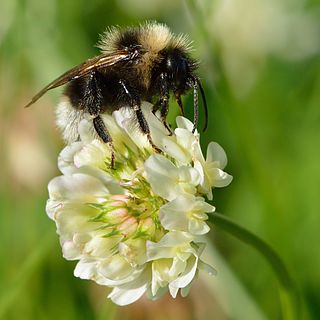
Trifolium repens, the white clover, is a herbaceous perennial plant in the bean family Fabaceae. It is native to Europe, including the British Isles, and central Asia and is one of the most widely cultivated types of clover. It has been widely introduced worldwide as a forage crop, and is now also common in most grassy areas of North America and New Zealand. The species includes varieties often classed as small, intermediate and large, according to height, which reflects petiole length. The term “white clover” is applied to the species in general, “Dutch clover” is often applied to intermediate varieties, and “ladino clover” is applied to large varieties.

Trifolium pratense, the red clover, is a herbaceous species of flowering plant in the bean family Fabaceae, native to Europe, Western Asia, and northwest Africa, but planted and naturalised in many other regions.
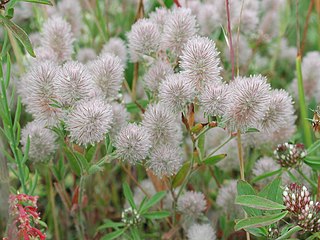
Trifolium arvense, commonly known as hare's-foot clover, rabbitfoot clover, stone clover or oldfield clover, is a flowering plant in the bean family Fabaceae. This species of clover is native to most of Europe, excluding the Arctic zone, and western Asia, in plain or mid-mountain habitats up to 1,600 metres (5,200 ft) altitude. It grows in dry sandy soils, both acidic and alkaline, typically found at the edge of fields, in wastelands, at the side of roads, on sand dunes, and opportunistically in vineyards and orchards when they are not irrigated.

Trifolium subterraneum, the subterranean clover, subterranean trefoil, is a species of clover native to northwestern Europe, from Ireland east to Belgium. The plant's name comes from its underground seed development (geocarpy), a characteristic not possessed by other clovers.
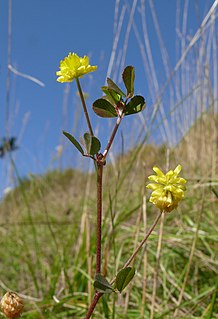
Trifolium campestre, commonly known as hop trefoil, field clover and low hop clover, is a species of clover native to Europe and western Asia, growing in dry, sandy grassland habitats, fields, woodland margins, roadsides, wastelands and cultivated land. The species name campestre means "of the fields".

Trifolium incarnatum, known as crimson clover or Italian clover, is a species of clover in the family Fabaceae, native to most of Europe. It has been introduced to other areas, including the United States and Japan. The species name incarnatum means "blood red".
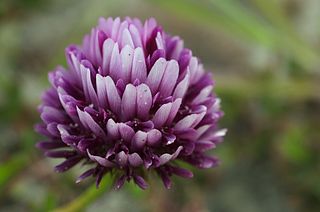
Trifolium wormskioldii is a species of clover. Its common names include cows clover, coast clover, sand clover, seaside clover, springbank clover, and Wormskjold's clover.

Trifolium amoenum, known by the common names showy Indian clover and two-fork clover, is endemic to California, and is an endangered annual herb that subsists in grassland areas of the San Francisco Bay Area and the northern California Coast Ranges.
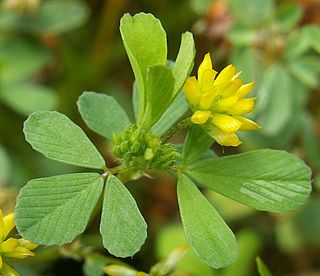
Trifolium dubium, the lesser trefoil, suckling clover, little hop clover or lesser hop trefoil, is a flowering plant in the pea and clover family Fabaceae. This species is generally accepted as the primary plant to represent the traditional Irish shamrock.

Trifolium medium, the zigzag clover, is a flowering plant species in the bean family Fabaceae. It is similar in appearance to red clover, Trifolium pratense, but the leaflets are narrower and have no white markings and the narrow stipules are not bristle-pointed. The species is native to Europe from Britain to the Caucasus.

Trifolium cyathiferum is a species of clover known by the common names cup clover and bowl clover.
Trifolium resupinatum is an annual clover used as fodder and hay, which reaches 60 cm (24 in) tall when cultivated, and forms rosettes when grazed or mowed. It is native to central and southern Europe, the Mediterranean, and southwest Asia as far south as the Punjab. It is an important hay crop in cold regions of Iran, Afghanistan and other Asian areas with cold winters.
Trifolium andersonii is a species of clover known by the common names fiveleaf clover and Anderson's clover. It is native to the western United States, particularly the Great Basin and adjacent high mountain ranges, including the Sierra Nevada.

Trifolium angustifolium is a species of clover known by the common names narrowleaf crimson clover, narrow clover and narrow-leaved clover.
Trifolium breweri, which has the common names forest clover and Brewer's clover, is a perennial clover that is native to mixed evergreen forests and coastal coniferous forests in southern Oregon and California. It belongs to the family Fabaceae, known for containing peas and other legumes. Its genus, Trifolium, which translates to “three leaf”, has a cosmopolitan distribution; the densest of which is found in the Northern Hemisphere.

Trifolium depauperatum is a species of clover known by the common names cowbag clover, poverty clover, and balloon sack clover.
Trifolium fucatum is a species of clover known by the common names bull clover and sour clover.
Trifolium gracilentum is a species of clover known by the common names pinpoint clover and slender clover. It is native to western North America including the west coast of the United States and northwestern Mexico, where it grows in many types of habitat, including disturbed areas. It is an annual herb growing prostrate to erect in form with mostly hairless or slightly hairy herbage. The leaves are made up of lance-shaped to oval leaflets. The inflorescence is an umbel of flowers that spread out or flex downward. The flowers have pink or purple corollas less than a centimeter long.
Trifolium jokerstii is a rare species of clover known by the common names Jim's clover and Butte County golden clover. It is endemic to Butte County, California, where it is known from eight or nine occurrences near Oroville. It grows in seasonally moist habitat, such as vernal pools, pastures, and ephemeral creeks. It was previously included within the description of Trifolium barbigerum as an odd yellow-flowered variant of a mostly purple-pink-flowered species, and was elevated to species status in 1998. It was named for the California botanist Jim Jokerst.














